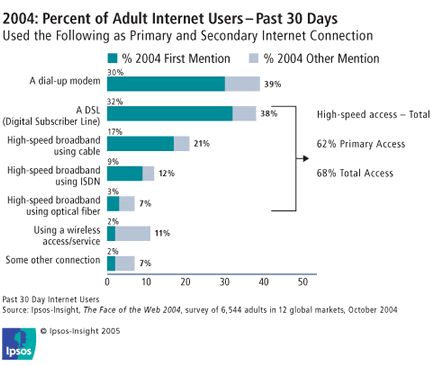| |
Broadband Majority
The number of people globally with broadband Internet access grew by 24% last year according to Ipsos-Insight's annual 'Face of the Web' study. A majority of US users now have high-speed connections, and growth in France, the UK and urban Brazil has been particularly pronounced this year.
Ipsos interviewed 6,544 adults, including 3,304 active Internet users, in 12 key global markets in October 2004. Fewer than a third of Internet Users now rely on narrowband dial-up as their primary access point. France, urban Brazil and the UK saw the highest growth in broadband usage (59%, 50%, and 45% respectively) but still have more users with narrowband access, while the US passed the 50/50 mark during 2004 and now has close to six out of ten users on a high-speed connection.
Half the globe's high-speed surfers use DSL, but in some regions (including North America and urban Russia) cable is the dominant high-speed format. Ipsos-Insight says that 'the majority of the households in urban markets of China and India have cable television access - the highest, in fact, relative to the measured markets - 97% and 96% respectively. Due to their sheer population sizes and wide cable access, they present enormous opportunity for future cable-broadband Internet connectivity'.
Fixed-line access currently accounts for 67% of the high-speed market, cable 28% and optical fibre 5%. The report says wireless Internet is 'a formidable new contender, with 11% of users having accessed the Internet through some wireless connection in 2004'.
Nilesh Modi, the study's co-author and Senior Analyst, expects many people to drop fixed-line services in favour of alternatives such as cable or optical fibre, or dial-up services in favour of fixed-line broadband options. Currently, countries can still be divided into two camps: those relying heavily on dial-up access vs. those who rely mainly on broadband. The former include the urban markets of Russia, India, Mexico, and Brazil, plus France and the UK.
According to Modi, 'consumers will be looking for bundled features to simplify their lives, combining wireless telecom to a cable or fixed-line offering, or combining their VoIP and wireless services'. Success will come from taking advantage of the multiple platforms available, and seamlessly integrating them.
The study covered Canada, France, Germany, Japan, South Korea, the UK, and the US plus urban areas of Brazil, China, India, Mexico and Russia. Data collected includes usage of household technologies relating to wireless communication, Internet access and future home networking; types of connectivity and future trends; global Internet awareness, trial and usage; and barriers to it.

The company is online at www.ipsos-insight.com

|
